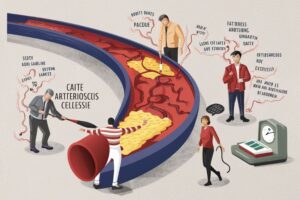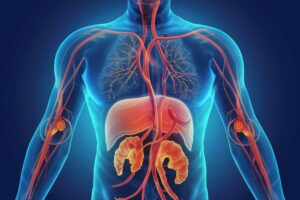What are the Causes and Symptoms of Arteriosclerosis and it’s Prevention and Treatment options?
Arteriosclerosis is a common condition characterized by the hardening and narrowing of the arteries, leading to restricted blood flow. Understanding the causes, symptoms, prevention strategies, and treatment options for arteriosclerosis is crucial in managing and mitigating its impact on overall health.
This article explores the in-depth details of arteriosclerosis, their causes, symptoms, prevention strategies, and treatment options for arteriosclerosis, lifestyle modifications and medical interventions aimed to combat arteriosclerosis and promoting overall heart health.

Table of Contents
ToggleDefinition and Introduction of Arteriosclerosis
Arteriosclerosis is a condition characterized by the thickening and hardening of the walls of arteries, which can lead to restricted blood flow and various cardiovascular diseases.
This condition is often a result of the accumulation of plaque, cholesterol, and other substances in the walls of the arteries, which causes them to lose their elasticity and become stiff. Arteriosclerosis is a progressive condition that can develop over time due to various factors such as high blood pressure, smoking, high cholesterol levels, diabetes, and a sedentary lifestyle.
The onset of arteriosclerosis can lead to serious health complications such as hypertension, heart attack, stroke, and peripheral artery disease. The narrowing of the arteries can reduce the flow of oxygen and nutrients to vital organs and tissues, leading to organ damage and dysfunction.
In severe cases, arteriosclerosis can result in the complete blockage of an artery, causing a sudden and life-threatening cardiovascular event. Early detection and management of arteriosclerosis through lifestyle modifications, medications, and interventions such as angioplasty or bypass surgery can help reduce the risk of complications and improve overall cardiovascular health.
In short, arteriosclerosis is a chronic condition that affects the arteries and can have serious implications for cardiovascular health. Understanding the causes, symptoms, and consequences of arteriosclerosis is crucial in the prevention and management of this condition.
By adopting a healthy lifestyle, managing risk factors, and seeking regular medical check-ups, individuals can take proactive steps to protect their cardiovascular system and prevent the progression of arteriosclerosis.
Read more about “Myeloid Leukemia Causes, Symptoms, Prevention and Treatments”
Types of Arteriosclerosis
There are several types of arteriosclerosis, with the two most common being atherosclerosis and Monckeberg’s arteriosclerosis. Atherosclerosis is the most prevalent form of arteriosclerosis and occurs when cholesterol and other fatty substances build up in the walls of arteries, forming plaques that can restrict blood flow.
This process can lead to the development of blood clots, which can cause blockages in the arteries and potentially result in a heart attack or stroke. Monckeberg’s arteriosclerosis, on the other hand, primarily affects the muscular arteries and is characterized by calcification of the walls of the arteries without the formation of plaques. This type of arteriosclerosis is often asymptomatic and typically does not cause significant narrowing of the arteries.

In addition to atherosclerosis and Monckeberg’s arteriosclerosis, other less common types of arteriosclerosis include arteriolosclerosis, which affects the smaller arterioles, and hyperplastic arteriosclerosis, which is typically seen in severe cases of hypertension.
Arteriolosclerosis is characterized by thickening and hardening of the walls of the smaller arteries, which can impede blood flow and lead to organ damage. Hyperplastic arteriosclerosis, on the other hand, is characterized by the proliferation of smooth muscle cells in the walls of the arteries, resulting in a narrowing of the blood vessels and an increased risk of complications such as stroke or kidney failure.
Understanding the different types of arteriosclerosis is crucial for proper diagnosis and management of the condition, as treatment approaches may vary depending on the specific type and severity of the disease.
Read more about “How to Cope with Depression in LGBTQIA+ Communities?”
Causes of Arteriosclerosis
One of the primary causes of arteriosclerosis is the buildup of plaque in the arteries, a process known as atherosclerosis. This occurs when fatty substances, cholesterol, calcium, and other substances found in the blood form deposits on the inner walls of the arteries, leading to the thickening and narrowing of these blood vessels.
This buildup of plaque can restrict blood flow to vital organs and tissues, increasing the risk of heart attack, stroke, and other cardiovascular complications.
In addition to atherosclerosis, other factors can contribute to the development of arteriosclerosis. These include lifestyle choices such as smoking, a diet high in saturated fats and cholesterol, lack of physical activity, and obesity. These risk factors can lead to high blood pressure, high cholesterol levels, and diabetes, all of which can contribute to the progression of arteriosclerosis.
Furthermore, genetic factors and a family history of cardiovascular disease can also play a role in the development of this condition. By understanding the various causes of arteriosclerosis, healthcare providers can help individuals make informed decisions about their health and take steps to prevent or manage this potentially life-threatening disease.
Read more about “What are the Causes and Symptoms of Periodontitis and how to Treat?”
Common Symptoms of Arteriosclerosis
One of the most common symptoms of arteriosclerosis is chest pain or angina, which occurs when the heart muscle does not receive enough oxygen due to narrowed arteries. This can result in a feeling of pressure, tightness, or discomfort in the chest that may radiate to the arms, neck, or back. Additionally, individuals with arteriosclerosis may experience shortness of breath, fatigue, and weakness, as the reduced blood flow to the muscles and organs can lead to decreased oxygen delivery and energy production.

Another common symptom of arteriosclerosis is peripheral artery disease (PAD), which refers to the narrowing of the arteries that supply blood to the limbs, particularly the legs. This can lead to pain, cramping, or numbness in the legs during physical activity, known as intermittent claudication.
In severe cases, PAD can cause ulcers or wounds on the feet or legs that heal slowly or not at all, due to the impaired circulation. Other symptoms of arteriosclerosis may include high blood pressure, dizziness, and headaches, as the heart works harder to pump blood through the narrowed arteries, leading to potential complications if left untreated.
Early detection and management of arteriosclerosis are crucial to prevent further damage and improve cardiovascular health.
Read more about “What are the Causes and Symptoms of Peripheral Artery Disease and how to treat?”
Diagnostic Tests for Arteriosclerosis
Diagnosing arteriosclerosis is crucial in order to prevent potentially life-threatening complications such as heart attack or stroke. There are several diagnostic tests that can be used to detect arteriosclerosis, including blood tests to measure cholesterol levels and detect markers of inflammation, imaging tests such as ultrasound, CT scan, or MRI to visualize the arteries and assess the extent of plaque buildup, and angiography to directly visualize the blood vessels and detect blockages.
One of the most commonly used diagnostic tests for arteriosclerosis is the coronary angiogram, which involves injecting a dye into the arteries and using X-ray imaging to visualize any blockages or narrowing in the coronary arteries.
Another important test is the ankle-brachial index, which measures the blood pressure in the ankles compared to the arms to assess the presence of peripheral artery disease.
Overall, early detection of arteriosclerosis through these diagnostic tests is essential for implementing appropriate treatment strategies and reducing the risk of complications associated with this condition.
Read more about “Atherosclerosis V/S Arteriosclerosis and Their Impact on Heart Health!”
Risk Factors Associated with Arteriosclerosis
Several risk factors have been identified that contribute to the development and progression of this condition. One of the primary risk factors associated with arteriosclerosis is high levels of cholesterol in the blood.
Elevated levels of LDL (low-density lipoprotein) cholesterol, also known as “bad” cholesterol, can lead to the formation of plaques in the arteries, narrowing the passageways and restricting blood flow.
In addition to high cholesterol levels, other risk factors for arteriosclerosis include high blood pressure, smoking, diabetes, obesity, and a sedentary lifestyle. High blood pressure can damage the arterial walls and increase the risk of plaque formation, while smoking can cause inflammation and damage to the arteries.
Diabetes is also a significant risk factor for arteriosclerosis, as it can lead to high blood sugar levels that can damage the blood vessels over time. Obesity and a lack of physical activity can also contribute to the development of arteriosclerosis by promoting the accumulation of plaque in the arteries.
Overall, managing these risk factors through lifestyle modifications such as a healthy diet, regular exercise, and abstaining from tobacco can help prevent or slow down the progression of arteriosclerosis and reduce the risk of cardiovascular events.
Prevention Strategies for Arteriosclerosis
Prevention strategies for arteriosclerosis are essential for maintaining cardiovascular health and reducing the risk of developing this condition. One of the most effective prevention strategies is adopting a healthy lifestyle, which includes maintaining a balanced diet, engaging in regular physical activity, and avoiding tobacco use.
A diet rich in fruits, vegetables, whole grains, and lean proteins can help reduce cholesterol levels and prevent the buildup of plaque in the arteries. Regular exercise can also help improve cardiovascular health by strengthening the heart and promoting circulation. Additionally, avoiding smoking and limiting alcohol consumption can further reduce the risk of arteriosclerosis.
In addition to lifestyle changes, monitoring and managing risk factors for arteriosclerosis is crucial for prevention. This involves regular check-ups with healthcare professionals to monitor blood pressure, cholesterol levels, and overall cardiovascular health.
Managing conditions such as high blood pressure, high cholesterol, and diabetes through medication and lifestyle modifications can help prevent the progression of arteriosclerosis.
Understanding one’s genetic predisposition to cardiovascular diseases and making lifestyle adjustments accordingly can also play a significant role in prevention.
By implementing these prevention strategies, individuals can reduce their risk of developing arteriosclerosis and improve their overall cardiovascular health.
Treatment Options for Arteriosclerosis
There are several treatment options available to manage and improve the symptoms of arteriosclerosis. One common treatment is lifestyle modifications, such as maintaining a healthy diet, regular exercise, and quitting smoking.
These lifestyle changes can help reduce cholesterol levels and blood pressure, which are key risk factors for arteriosclerosis. Additionally, medication therapy can be prescribed to help lower cholesterol levels, reduce blood pressure, and prevent blood clots. These medications may include statins, blood pressure medications, and blood thinners.
In severe cases, surgical interventions such as angioplasty or bypass surgery may be necessary to restore blood flow to the affected arteries.

In recent years, there has been growing interest in alternative treatment options for arteriosclerosis, such as dietary supplements and herbal remedies. Some studies have suggested that certain supplements, such as omega-3 fatty acids, garlic, and green tea, may have protective effects on cardiovascular health and help reduce the progression of arteriosclerosis.
However, more research is needed to determine the effectiveness and safety of these alternative treatments. It is important for patients with arteriosclerosis to work closely with their healthcare provider to develop a comprehensive treatment plan that addresses their individual risk factors and health needs.
By incorporating a combination of lifestyle changes, medications, and possibly alternative therapies, individuals with arteriosclerosis can effectively manage their condition and reduce their risk of serious complications.
Lifestyle Changes for Managing Arteriosclerosis
Lifestyle changes play a crucial role in managing arteriosclerosis and preventing its progression. One of the key strategies is adopting a healthy diet that is low in saturated fats, cholesterol, and sodium, and high in fruits, vegetables, whole grains, and lean protein.
This can help to lower blood pressure, reduce plaque buildup in the arteries, and improve overall cardiovascular health. Regular exercise is also essential for managing arteriosclerosis, as it helps to improve circulation, strengthen the heart muscle, and maintain a healthy weight. Aim for at least 150 minutes of moderate-intensity aerobic exercise per week, along with muscle-strengthening activities on 2 or more days.
In addition to diet and exercise, managing stress is another important aspect of preventing and managing arteriosclerosis. Chronic stress can contribute to high blood pressure and inflammation, both of which can worsen arteriosclerosis.
Techniques such as mindfulness meditation, deep breathing exercises, and yoga can help to reduce stress levels and promote relaxation.
It is also important to quit smoking and limit alcohol consumption, as both habits can increase the risk of arteriosclerosis and other cardiovascular diseases. By making these lifestyle changes, individuals can take control of their health and reduce their risk of complications from arteriosclerosis.
Conclusion:
In conclusion, maintaining a proactive approach towards arteriosclerosis by adopting healthy lifestyle choices, seeking proper medical guidance, and staying informed about preventive measures can significantly impact the progression of this condition.
By prioritizing heart health and making informed decisions, individuals can work towards reducing the impact of arteriosclerosis and improving their overall well-being. Remember, knowledge and action are key to manage arteriosclerosis effectively and pave the way for a healthier future.
FREQUENTLY ASKED QUESTIONS
1. What are the early warning signs of arteriosclerosis?
Early warning signs of arteriosclerosis may include chest pain or angina, shortness of breath, fatigue, dizziness, or fainting episodes. Additionally, individuals may experience numbness or weakness in extremities, especially in the legs and arms. Other indicators include erectile dysfunction in men and poor wound healing.
It is important to seek medical attention if any of these symptoms are present, as early detection and management can help prevent progression of arteriosclerosis and reduce the risk of serious cardiovascular events. Screening tests such as cholesterol level measurements, blood pressure monitoring, and imaging scans like ultrasounds or coronary angiography can aid in diagnosing arteriosclerosis in its early stages.
2. Can arteriosclerosis be reversed through lifestyle changes alone?
Arteriosclerosis can be partially reversed through lifestyle changes alone. By adopting a heart-healthy diet low in saturated fats and cholesterol, maintaining a healthy weight, engaging in regular physical activity, quitting smoking, and managing stress levels effectively, individuals can slow down or even halt the progression of arteriosclerosis. These lifestyle modifications can also help improve blood flow, reduce blood pressure, and lower cholesterol levels, all of which are crucial factors in preventing further damage to the arteries.
However, it is important to note that complete reversal of arteriosclerosis through lifestyle changes alone may not always be possible, especially in cases where the condition is advanced. Therefore, it is essential for individuals with arteriosclerosis to work closely with their healthcare providers to develop a comprehensive treatment plan that may include medication or other interventions in addition to lifestyle modifications.
3. What lifestyle changes can help prevent or slow down the progression of arteriosclerosis?
Arteriosclerosis can be prevented or slowed down through various lifestyle modifications. Adopting a healthy diet rich in fruits, vegetables, whole grains, and lean proteins can help reduce cholesterol levels and prevent plaque buildup. Regular physical activity is also essential for maintaining cardiovascular health and preventing arteriosclerosis. Smoking cessation is crucial as smoking not only damages the arterial walls but also increases cholesterol levels.
Managing stress through relaxation techniques such as meditation or yoga can help lower blood pressure and reduce the risk of developing arteriosclerosis. Lastly, maintaining a healthy weight and keeping blood sugar levels under control are vital components of preventing or slowing down the progression of this condition. By incorporating these lifestyle changes into daily routines, individuals can significantly improve their heart health and reduce their risk of arteriosclerosis.


